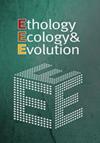山雀嘶嘶的叫声会引起松鼠的警惕
IF 1.1
4区 生物学
Q4 BEHAVIORAL SCIENCES
引用次数: 2
摘要
山雀科的繁殖山雀在遇到捕食者时会发出嘶嘶的叫声,这被认为是声学贝叶斯模仿。只有在几项研究中才证实了Paridae的嘶嘶叫声的抗捕食作用。为了确定日本山雀(Parus minor)的嘶嘶叫声是否会影响巢穴捕食者斯文虎纹松鼠(Tamiops swinhoei)的摄食行为,我们播放了白噪音、东方斑鸠(Streptopelia orientalis)的叫声和日本山雀对松鼠的嘶嘶叫声。松鼠对播放的三种声音有不同的反应。在播放山雀嘶嘶叫声时,松鼠仍进食的比例(26.1%)显著低于播放白噪音(91.3%)和鸽子叫声(85.7%)时。饲养松鼠对山雀嘶嘶叫声的警觉时间也明显长于对白噪声和鸽子叫声的警觉时间。我们的研究表明,山雀的嘶嘶叫声可以改变巢捕食者松鼠的摄食行为,从而可能减少腔鸟的巢捕食。本文章由计算机程序翻译,如有差异,请以英文原文为准。
Hissing calls of tits elicit vigilance in feeding squirrels
Breeding tits in the family Paridae let out a hissing call when encountering nest predators, which is thought to be acoustic Batesian mimicry. The antipredator effect of the hissing call of Paridae has only been confirmed in several studies. To identify whether the hissing call of Japanese tits (Parus minor) affects the feeding behavior of the nest predator Swinhoe’s striped squirrel (Tamiops swinhoei), we played back white noise, the call of Oriental turtle doves (Streptopelia orientalis), and the hissing call of Japanese tits to squirrels. The squirrels responded differently to the three types of sounds played back. The proportion of squirrels that still fed while the hissing call of tits being played (26.1%) was significantly lower than that when white noise (91.3%) and the call of doves (85.7%) being played. The alert time of feeding squirrels to the hissing call of tits was also significantly longer than that to white noise and the call of doves. Our study suggests that the hissing call of tits can change the feeding behavior of the nest predator squirrel, which may reduce nest predation in cavity birds.
求助全文
通过发布文献求助,成功后即可免费获取论文全文。
去求助
来源期刊

Ethology Ecology & Evolution
生物-动物学
CiteScore
3.10
自引率
0.00%
发文量
44
审稿时长
>12 weeks
期刊介绍:
Ethology Ecology & Evolution is an international peer reviewed journal which publishes original research and review articles on all aspects of animal behaviour, ecology and evolution. Articles should emphasise the significance of the research for understanding the function, ecology, evolution or genetics of behaviour. Contributions are also sought on aspects of ethology, ecology, evolution and genetics relevant to conservation.
Research articles may be in the form of full length papers or short research reports. The Editor encourages the submission of short papers containing critical discussion of current issues in all the above areas. Monograph-length manuscripts on topics of major interest, as well as descriptions of new methods are welcome. A Forum, Letters to Editor and Book Reviews are also included. Special Issues are also occasionally published.
 求助内容:
求助内容: 应助结果提醒方式:
应助结果提醒方式:


